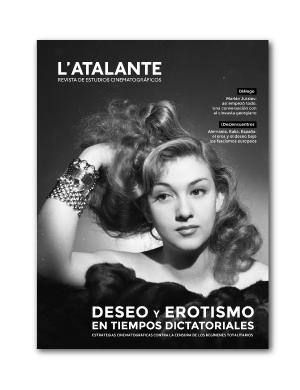Publicado 01.01.2017
Palabras clave
- Las margaritas,
- subversión,
- censura,
- Checoslovaquia,
- Věra Chytilová
- Nueva Ola Checa. ...Más
Cómo citar
Derechos de autor 2017 L'Atalante. Revista de estudios cinematográficos

Esta obra está bajo una licencia internacional Creative Commons Atribución-NoComercial-SinDerivadas 4.0.
Resumen
El erotismo, la ambigüedad y la experimentación hacen de Las margaritas una película tan subversiva que a sus cincuenta años sigue dando que hablar. El existencialismo y el desencanto de esta obra de vanguardia se expresan a través de la performance de sus personajes principales: dos muñecas, dos imágenes o dos artistas contemporáneas que se burlan y destruyen todo lo que se considera normal y correcto. La crítica de Věra Chytilová a la sociedad checoslovaca de los sesenta es oblicua, pero está latente en cada gesto, composición y en cada recurso de montaje. En este artículo rastreamos las estrategias de esa directora de la Nueva Ola Checa en su creación de una obra revolucionaria sin adscribirse a la representación del realismo socialista. Es una obra crítica hacia todas las convenciones que no permite a los censores, espectadores y analistas ningún encasillamiento. En nuestro análisis desvelamos los mecanismos que hacen funcionar la fascinación y el rechazo a través de la seducción y el distanciamiento de manera ambigua.
Descargas
Citas
Bazin, André (2005). The virtues and limitations of montage. In A. Bazin (ed.), ¿What is cinema? Vol. I (pp. 41-52). Berkeley: University of California Press.</p><p>
Chytilová, Věra (1976). I want to work. Index on Censorship, 5 (2), 17-22.</p><p>
Clouzot, Claire (1968). Daisies. Film Quarterly, 21 (3), 35-37.</p><p>
Elsaesser, Thomas (2005). European Cinema. Face to face with Hollywood. Amsterdam: Amsterdam University Press.</p><p>
Hames, Peter (2005). Czechoslovak New Wave. London: Wallflower Press.</p><p>
—(2009). Czech and Slovak Cinema. Theme and Tradition. London: Wallflower Press.</p><p>
—(2014). Alienated Heroes: Marxism and the Czechoslovak New Wave. En E. Mazierska y L. Kristensen (eds.), Marx at the movies (pp. 147-170). New York: Palgrave Macmillan.</p><p>
Hanáková, Petra (2005). Voices from Another World: Feminine Space and Masculine Intrusion in Sedmikrásky and Vražda ing. Cěrta. En A. Imre, East European Cinemas (pp. 63–77). London y New York: Routledge.</p><p>
Hanáková, Petra (2014). The Feminist Style in Czechoslovak Cinema: The Feminine Imprint in the Films of Věra Chytilová and Ester Krumbachová. En H. Havelková y L. Oates-Indruchová, The Politics of Gender Culture under State Socialism: An Expropriated Voice (pp. 211-233). London and New York: Routledge.</p><p>
Huebner, Karla Tonine (2008). Eroticism, identity, and cultural context: Toyen and the Prague Avant-Garde. Doctorate thesis. Pittsburgh: University of Pittsburgh.</p><p>
Léger, Marc James (2015). Drive in Cinema. Essays on Film, Theory and Politics. Chicago: Intellect. The University of Chicago Press.</p><p>
Lim, Bliss Cua (2001). Dolls in Fragments: Daisies as Feminist Allegory. Camera Obscura, 47 (16.2), 37-77.</p><p>
Miljević, Radojka (1995). Review. The Slavonic and East European Review, 73 (2), 391-393. </p><p>
Nabokov, Vladimir (1975). Lolita. Barcelona: Ediciones Grijalbo.</p><p>
Němcová Tejkalová, Alice, Šára, Filip, Sorfa, David (2015). Czech Republic. In J. Nelmes, J. Selbo (eds.), Women Screenwriters (pp. 249-265). New York: Palgrave McMillan.</p><p>
Owen, Jonathan (2013). Avant-Garde to New Wave: Czechoslovak Cinema, Surrealism and the Sixties. New York: Berghahn-Books.</p><p>
Pružinec, Jaroslav (1967). Discurso en la asamblea nacional. Biblioteca digital del parlamento checoslovaco. 18 de marzo 1967. Retrieved from: <http://www.psp.cz/eknih/1964ns/stenprot/015schuz/s015015.htm> [08/04/2016].</p><p>
Rupnik, Jacques (1975). The politics of culture in Czechoslovakia. Retrieved from: <http://www.thecrimson.com/article/1975/5/20/the-politics-of-culture-in-czechoslovakia/>.</p><p>
Seal, John (2012). Reviewed: ‘Daisies,’ an exercise in cheeky absurdity. Retrieved from: <http://www.berkeleyside.com/2012/06/07/big-screen-berkeley-daisies/>.</p><p>
Šmejkalová, Jiřina (2001). Censors and their readers: Selling, Silencing, and Reading Czech Books. Libraries & Culture, 36 (1), 87-103.</p><p>
Sorfa, David (2013). Beyond Work and Sex in Czech Cinema. In E. Mazierska (ed.), Work in Cinema: Labor and the Human Condition (pp. 133-150). London: Palgrave Macmillan.</p><p>
Soukup, Katarina (1998). Banquet of Profanities: Food and Subversion in Věra Chytilová’s Daisies. Tessera, 24, 38-52.</p><p>
Weibgen, Lara (2009). Performance as ‘Ethical Memento’: Art and Self-Sacrifice in Communist Czechoslovakia. Third Text, 23 (1), 55-64.</p><p>
Weidner, Chad (2016). A Land of Grass without Mirrors: The Dada Ecopoetics of Moving Images in William Burroughs’ Nova Express and Věra Chytilová’s Sedmikrasky (Daisies). En C. Weidner (ed.), The Green Ghost (pp. 74-83). Carbondale : Southern Illinois University Press.</p>
</body>

